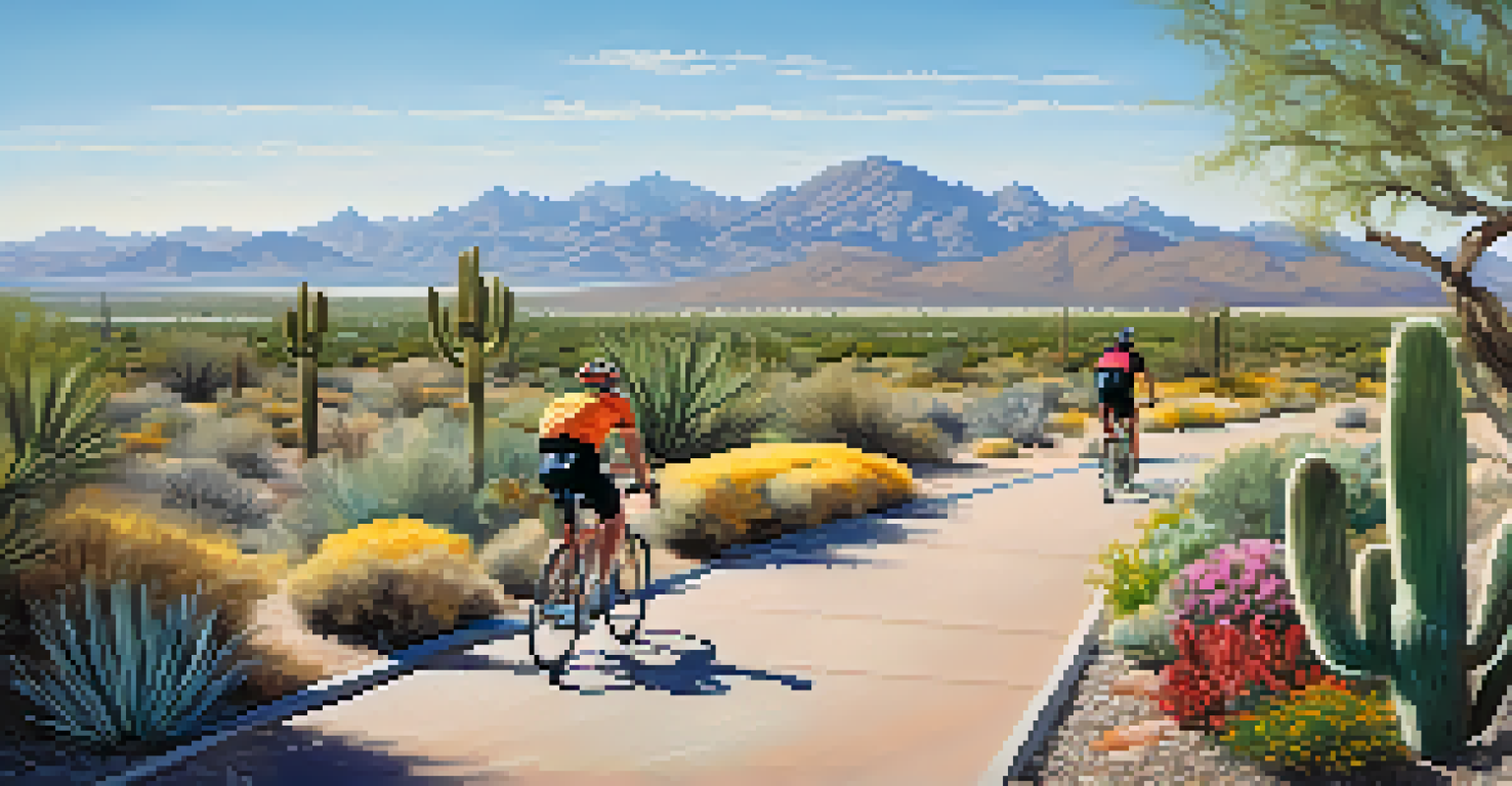Bicycle Infrastructure Development in Arizona

The Current State of Bicycle Infrastructure in Arizona
Arizona's bicycle infrastructure has evolved significantly in recent years, yet it still faces challenges. Major cities like Phoenix and Tucson have made strides in creating bike lanes and trails, but rural areas often lack the same level of development. This disparity can discourage cycling as a viable transportation option across the state.
Bicycling is a big part of the future of cities, and it has the potential to reshape urban landscapes for the better.
In urban areas, the presence of bike-sharing programs and designated bike lanes has seen an increase in ridership. However, safety concerns remain a top issue, particularly in regions without proper signage or protected lanes. As a result, many potential cyclists hesitate to take to the roads, fearing for their safety.
Addressing these concerns through better planning and investment in infrastructure will be crucial for promoting cycling as a sustainable mode of transport. By understanding the current landscape, stakeholders can identify areas for improvement and foster a more bike-friendly Arizona.
The Benefits of Bicycle Infrastructure Development
Investing in bicycle infrastructure offers numerous benefits, from health improvements to economic boosts. Regular cycling promotes physical health, reducing the risks of chronic diseases while encouraging a more active lifestyle. Additionally, improved air quality from fewer cars on the road can lead to better overall community health.

Economically, cities that enhance their cycling infrastructure often see an increase in local business revenues. Cyclists tend to shop more frequently and spend money at nearby establishments. This means that investing in bike paths and lanes not only benefits cyclists but also stimulates local economies.
Bicycle Infrastructure Needs Improvement
Arizona's bicycle infrastructure is developing but still struggles with safety and accessibility, especially in rural areas.
Moreover, developing bicycle infrastructure contributes to environmental sustainability. By encouraging residents to choose biking over driving, cities can reduce their carbon footprint and improve urban livability. It’s a win-win situation that benefits individuals and the community as a whole.
Key Challenges in Developing Bicycle Infrastructure
Despite the many benefits, several challenges hinder the development of bicycle infrastructure in Arizona. One significant issue is funding; many municipalities struggle to allocate sufficient resources for bike projects amidst competing priorities. This can lead to incomplete networks and inadequate maintenance of existing paths.
Cycling is not just a mode of transport; it is a lifestyle that promotes health, well-being, and community engagement.
Another challenge is community resistance. Some residents may view bike lanes as a reduction of road space for vehicles, leading to pushback during planning stages. Engaging the community early in the planning process can help alleviate concerns and foster support for bike-friendly initiatives.
Additionally, the climate in Arizona poses unique obstacles for cyclists. Extreme heat can deter riding during certain times of the year, making it essential for planners to consider shaded routes and cooling stations. Addressing these challenges head-on will be crucial for creating a robust bicycle infrastructure.
Successful Case Studies: Phoenix and Tucson
Phoenix and Tucson have emerged as leaders in bicycle infrastructure development in Arizona. Phoenix initiated the 'Complete Streets' program, which aims to create a more balanced transportation network, integrating bike lanes into major roads. This approach has led to increased cycling participation and community engagement.
Tucson, on the other hand, has focused on expanding its extensive bike path system, providing residents with safe and enjoyable routes. The city's commitment to hosting events like the 'Bike Fest' encourages more people to explore cycling as a viable option for commuting and recreation. These initiatives highlight the importance of community involvement in successful infrastructure development.
Community Support Drives Success
Successful bicycle infrastructure projects in Phoenix and Tucson highlight the importance of community involvement and advocacy.
Both cities serve as examples of how effective planning and community engagement can lead to positive outcomes. Their successes can inspire other areas in Arizona to invest in similar projects, ultimately promoting a culture of cycling across the state.
The Role of Advocacy Groups in Bicycle Development
Advocacy groups play a crucial role in pushing for bicycle infrastructure improvements in Arizona. Organizations like the Arizona Bicycle Association work tirelessly to promote cycling-friendly policies and raise awareness about the benefits of biking. Their efforts often lead to increased funding and support from local governments.
These groups not only advocate for better infrastructure but also engage in education and outreach initiatives. By hosting workshops and community rides, they help demystify cycling for new riders and address safety concerns. Building a strong cycling community is essential for long-term infrastructure success.
Collaborating with local governments, advocacy groups can help shape policies that prioritize cyclist safety and accessibility. Their grassroots efforts can lead to significant changes, making Arizona a more bike-friendly state for all.
Future Trends in Bicycle Infrastructure Development
Looking ahead, several trends are emerging in bicycle infrastructure development in Arizona. One notable trend is the increasing focus on integrating technology into cycling infrastructure. Smart bike lanes equipped with sensors can provide real-time data on traffic and usage, improving safety and planning.
Additionally, the popularity of electric bikes (e-bikes) is reshaping how people view cycling. As e-bikes become more accessible, cities will need to adapt their infrastructure to accommodate these riders, ensuring safety and comfort. This may include creating dedicated lanes or charging stations along popular routes.
Future Trends Embrace Technology
Emerging trends in Arizona's cycling infrastructure include the integration of technology and the rise of e-bikes, promoting a more connected transport system.
Lastly, there’s a growing emphasis on creating multi-modal transportation options. By integrating bike networks with public transit systems, Arizona can offer seamless travel solutions that encourage more people to choose cycling. This holistic approach will make biking an attractive option for everyone.
How Residents Can Get Involved in Bicycle Development
Residents in Arizona can play a pivotal role in bicycle infrastructure development. One of the most effective ways to get involved is by attending local planning meetings and voicing support for bike-friendly initiatives. Engaging with local officials can help ensure that cycling needs are prioritized in future projects.
Additionally, community members can join local advocacy groups to amplify their voices. These organizations often welcome volunteers to help with events, campaigns, and outreach efforts. Together, residents can push for changes that benefit cyclists and the community as a whole.

Lastly, participating in community rides and events can help raise awareness about the importance of cycling in Arizona. By showing support for local infrastructure initiatives, residents can foster a culture of cycling that encourages others to join in and advocate for change.